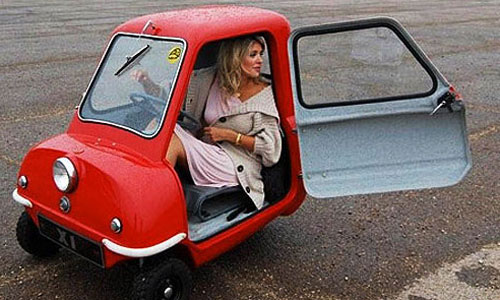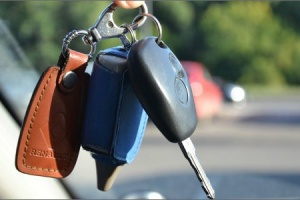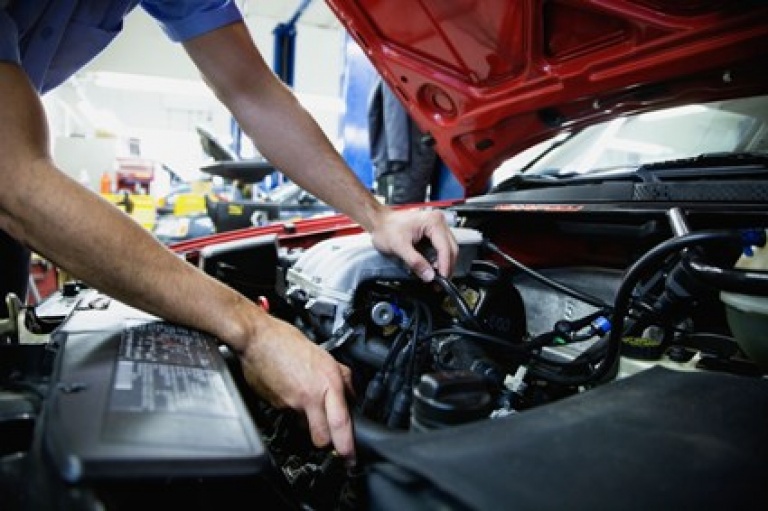Self-propelled vehicle definition of traffic rules. Mechanical vehicle - a universal vehicle for movement
non-mechanical vehicle is set in motion with the help of muscular energy (human or animal). Non-mechanical vehicles of the Rules include a horse-drawn cart, a bicycle, a moped and, perhaps, a wheelchair.

Reference. A moped, although it has an engine, is already very low-powered, and in terms of speed, maneuverability and weight it is not much different from a bicycle. In addition, an appropriate document (driver's license) is required to drive a motor vehicle. In the case of a moped, perhaps this would be unjustified. Therefore, the Rules classified the moped as a non-mechanical vehicle.
Non-mechanical vehicles generally include all two- and three-wheeled vehicles with an engine displacement of not more than 50 cubic meters. cm. and a design speed of not more than 50 km / h.
It should be borne in mind that drivers of non-motorized vehicles are full participants traffic. The rules allowed them to be used for road traffic common use with all the ensuing rights and obligations.

Rules. Section 1. motor vehicle- a vehicle, other than a moped, propelled by an engine. The term also applies to any tractors and self-propelled machines.
The list of motor vehicles is extensive. These are motorcycles, and cars, and trucks, and buses, and trolleybuses, and tractors, and self-propelled chassis, and truck cranes, and bulldozers, and excavators, and so on and so on. In short, a motor vehicle is any self-propelled machine, as long as it is designed to transport people and goods (or to transport equipment installed on it).
Obviously, riding a motorcycle requires one set of skills, while driving a car requires a completely different set of skills. It is obvious that a person who confidently drives a car is unlikely to feel confident in the cab of a KamAZ, and will be completely confused if he is put behind the wheel of a road train (a cargo tractor with a trailer, or even two).
It is logical that all mechanical vehicles, according to their driving skills, are divided into separate categories. The categories of vehicles that the driver is allowed to drive are specified in his driver's license. To get permission to drive a particular category of vehicles, you must complete a special training course.
The following categories of motor vehicles are accepted in Russia:
The number of seats for passengers is not more than eight.
Allowed maximum weight- no more than 3.5 tons.
At the same time, each of the categories lives its own independent life. What I mean? If category "A" is open in the driver's license, then only motorcycles can be driven. And nothing else! If category "B" is open, then only vehicles of category "B" can be driven. And nothing else! And the same goes for all other categories.
Well, then it would be nice to figure out where exactly the boundaries between the categories of motor vehicles lie.
Rules. Section 1. Motorcycle- a two-wheeled motor vehicle with or without a side trailer. Motorcycles are equated to three- and four-wheeled motor vehicles with a curb weight of not more than 400 kg.
That is, according to the Rules, in order to be called a motorcycle, it doesn’t matter at all how many wheels you have (two, three or four), the main distinguishing feature is the curb weight! And if this mass is not more than 400 kg, then you are a motorcycle.
And the curb weight is what it is - this is the mass of the vehicle completely ready for operation. That is, with all the accessories necessary for operation (fire extinguisher, first aid kit, sign emergency stop), with all the necessary operational consumables(engine oil, coolant), a full tank of fuel, but without passengers and cargo.
 Student. What happens if you make a car whose curb weight does not exceed 400 kg, then you can drive it with the rights of a motorcyclist?
Student. What happens if you make a car whose curb weight does not exceed 400 kg, then you can drive it with the rights of a motorcyclist?
Teacher. Yes, that's right - you can (and should!) manage it with the rights of category "A". Otherwise, at the first check on the road, you will be removed from control, and the vehicle will be detained and placed in a car impound.
Student. On what basis?
Teacher. On the basis of part 1 of article 12.3 of the Code of Administrative Offenses of the Russian Federation: “Driving a vehicle (vehicle) by a driver who does not have with him the documents provided for in clause 2.1.1 of the SDA.”
Any self-propelled vehicle of categories M and N in accordance with the classification established by GOST R 52051. [GOST R 41.13 2007] Any self-propelled vehicle. [GOST R 52389 2005] Topics… …
- - a vehicle, except for a moped, driven by an engine (from the SDA). Edwart. Dictionary of automotive jargon, 2009 ... Automobile dictionary
motor vehicle- a vehicle, other than a moped, propelled by an engine. The term also applies to any tractors and self-propelled vehicles ... Source: Decree of the Government of the Russian Federation dated 10/23/1993 N 1090 (as amended on 11/12/2012) On the Rules of the road ... ... Official terminology
motor vehicle- 2.1.1 mechanical vehicle (mechanical vehicle, power driven vehicle): Any self-propelled vehicle of categories M and N in accordance with the classification established by GOST R 52051. Source ...
motor vehicle- ▲ machine being (than), transportation power-driven vehicle motor-driven vehicle …
motor vehicle- a vehicle, other than a moped, propelled by an engine. The term also applies to any tractors and self-propelled machines. Rules approved by the decision of the Council of Ministers of the Government Russian Federation dated 10/23/93 N… … Dictionary of legal concepts
Main article: Transport Cars are now the most common vehicles using an internal combustion engine ... Wikipedia
vehicle- Ground mechanical device on wheels of categories L, M, N, O, intended for operation on highways common use. [Technical regulation on the safety of wheeled vehicles] Motor transport topics ... ... Technical Translator's Handbook
vehicle- 2.1 vehicle: A single deck vehicle designed and equipped to carry more than 22 passengers. There are three classes of vehicles. It is allowed to use the vehicle in more than one ... ... Dictionary-reference book of terms of normative and technical documentation
stationary vehicle- ▲ Stationary motor vehicle A stationary vehicle moves a load over a short distance, reloads … Ideographic Dictionary of the Russian Language
Books
- Bus, Jesse Russell. This book will be produced in accordance with your order using Print-on-Demand technology. High Quality Content by WIKIPEDIA articles! Avto?bus (short for omnibus car) - ...
- Is a moped a motor vehicle?
- On October 22, 2009, new traffic rules were adopted by Presidential Decree No. 744. They say that “a moped is a two- or three-wheeled vehicle driven by an engine with a working volume of not more than 50 cubic meters. cm and having a maximum design speed of not more than 50 km / h. Bicycles with an outboard engine, mokiks and other vehicles with similar characteristics are equated to mopeds. IN new traffic rules the concept of "power-driven vehicle" was also changed - this is a vehicle driven by an engine. Thus, mopeds were classified as motor vehicles.
- So, to drive a moped, you need to pass on the rights?
- All drivers of motor vehicles must be trained to drive them and obtain a driver's license. The concept of a motor vehicle includes cars, cars, trucks, and motorcycles, including mopeds. Thus, moped drivers are required to obtain rights and comply with traffic rules on an equal basis with other drivers.
So it was different before?
- Yes, according to the old Rules of 2002, the moped, indeed, did not belong to mechanical vehicles. You don't need a driver's license to drive a moped. Moreover, until November 22, 2009, moped drivers were liable under Article 128 of the Code administrative offenses i.e. both cyclists and pedestrians. At the moment, they are responsible on a common basis with all drivers of motor vehicles. For example, the punishment for driving while intoxicated is the same for both a car and a moped: the driver will be deprived of his license or subject to a fine.
- In connection with what was it decided to equate mopeds to mechanical vehicles?
- This is a forced measure. According to the norms, it is written that mopeds are limited to a speed of 50-60 km / h, but in fact they are able to develop it up to 80-100 km / h. In the city, even 60 km is a solid speed within which all cars move, therefore the moped driver must adhere to the general rules.
We all watched what young people do on mopeds in evening time days in Tiraspol and Bendery. In the past, moped drivers were not held liable on a par with drivers of other vehicles. For example, if a moped was driven by a young man in a state of alcohol intoxication, then a protocol was drawn up against him under Article 128, which provides for a fine in the amount of 5 RU of the minimum wage (about 70 rubles). At the moment, for this violation, the moped driver is provided with a fine of 100 to 200 RU MPZ (from 1450 to 2900 rubles), and in case of a repeated violation - deprivation of a driver's license for a period of 2 to 3 years. You understand that there is a difference between a fine of 70 rubles and 2900 rubles. The same young man is already thinking about whether it is worth driving while intoxicated. Moreover, if he is caught drunk driving a moped, he may lose his license to drive a car.
Now moped drivers have become more disciplined, do not allow themselves to pass a red traffic light or not give way to a vehicle moving on main road. Mopeds are driven by more mature people who follow traffic rules. According to the traffic police statistics of the PMR, the level of traffic accidents involving drivers of this type of vehicle has significantly decreased.
I want to note that the problem with mopeds exists now in neighboring states. The State Duma of the Russian Federation is currently considering the introduction of a separate category for drivers of this type of transport. As for Europe, there in many states it has long been necessary to have rights to mopeds.

New rules were adopted in 2009. Why didn’t they immediately begin to demand from moped drivers, as from drivers of the same cars?
- The fact is that there was no separate category for mopeds in the driver's licenses. Therefore, we first obliged moped drivers to carry a certificate of completion of traffic rules courses for driving a moped. But with the order of the Minister of Internal Affairs "On approval of a single model of a driver's license", issued on December 17, 2010, everything changed.
The new type of driver's license introduced a separate category for moped drivers. If earlier the category "A" referred only to the management of motorcycles, then at the moment it is divided into three categories, to which drivers can be admitted different ages. The first category - "AM" - is required for drivers of mopeds, persons who have reached the age of 14 are allowed to drive. The second category "A1" refers to the drivers of motorcycles, the engine capacity of which does not exceed 125 cubic meters. see It can be obtained by citizens from the age of 16. And the third category "A" covers motorcycles with an engine capacity of more than 125 cc. see and available to persons over 18 years of age.
Now moped drivers have to know the traffic rules at the level of drivers of other motor vehicles, and therefore, in order to obtain a license, they study at a driving school and pass exams. Those who have already managed to take courses during this time do not need to re-train, they only pass an exam at the MREO GAI and receive a driver's license with the category "AM".
Interviewed by Irina Koloydenko
On this topic.
Below are the main concepts and terms that are used in the SDA (section 1. General provisions), grouped by topic. Please note that the explanations of concepts and terms are not given in the original language, but more simply and clearly.
Vehicle (TS). A device designed to transport people, goods or equipment along the roads. Please note that vehicles include not only mechanical transport, but also non-mechanical (without an engine).
motor vehicle . A vehicle that is propelled by an engine, including tractors and self-propelled machines. The concept of a motor vehicle is narrower than a vehicle. Mechanical vehicles include: cars, motorcycles, tractors, graders, scrapers, asphalt pavers, trams, trolleybuses, etc.
Equipped mechanical vehicle - a vehicle fully filled with fuel, with the maximum level of oil and coolant, with a spare wheel, first aid kit, warning triangle.
Motorcycle. Two-wheeled motor vehicle with or without a side trailer, with an engine capacity of more than 50 cubic centimeters or a maximum design speed (regardless of the engine) of more than 50 km/h. Motorcycles include tricycles, ATVs with a motorcycle seat or motorcycle-type handlebars, with an unladen weight of not more than 400 kg (550 kg for trucks) excluding the mass of batteries (for electric vehicles), and a maximum effective engine power of not more than 15 kW.
Moped. 2- or 3-wheeled mechanical vehicle with a maximum design speed of not more than 50 km / h, with an internal combustion engine whose volume does not exceed 50 cubic centimeters or an electric motor with a rated maximum power in continuous load mode of 0.25-4 kW. ATVs with similar technical characteristics are equated to mopeds.
Bike. TS, except wheelchairs, having two (or more) wheels, and set in motion by the muscular power of the cyclist (using pedals or handles). A bicycle is not a motor vehicle. The bicycle may have an electric motor with a rated maximum power in continuous load mode of not more than 0.25 kW, which automatically turns off at a speed of more than 25 km/h. Riding a bicycle is equivalent to driving, respectively, a cyclist is a driver who is endowed with a number of rights and obligations. At the same time, the face leading bike in hand, is a pedestrian.
road train. A motor vehicle that is coupled to one (several) trailers. The cab of the road train is equipped with three lights orange color. A car with a trailer is also a road train, but it is not required to install an appropriate sign on it.
Shuttle vehicle . A public vehicle designed to transport people on the roads. The route vehicle moves along the established route with designated stops. Typical route vehicles: bus, trolleybus, tram. A facility is considered a route facility only when it transports people along an established route, moving from one designated stopping point to another. In other cases, the listed transport does not have the status of a route vehicle - i.e., moving from / to a depot, for example, a tram is not a route vehicle. Shuttle vehicles do not include taxis and departmental vehicles.
Trailer. A vehicle intended to be driven in combination with a mechanical vehicle and which does not have an engine. Trailers include semi-trailers and drop trailers. Driving with a trailer weighing more than 750 kg requires a category "E" driving license.
Permissible maximum weight . The mass of the equipped vehicle with cargo, driver and passengers, which is set by the manufacturer, is considered the maximum allowable. In the case of a combination of vehicles (road train) coupled and moving as a whole, the permitted maximum mass is equal to the sum of the permitted maximum masses of the vehicles included in the composition.
A mechanical vehicle installation is called, which moves with the help of an engine. Vehicle transport installations on mechanics are characterized by a wide range and are presented in the form of buses, trams, cars, tractors, motorcycles, trolleybuses, motorized carriages, etc. They differ from each other in design elements and principles of operation.
Dear readers! The article describes typical ways of how to solve legal problems. Your case is individual.
A motor vehicle is a self-propelled machine
Motor transport installations on mechanics belong to the category of self-propelled machines, the design and manufacture of which is carried out in order to use them on roads that have a common purpose. Vehicles are characterized by the presence of at least two wheels.
This technique must be used in accordance with the rules of the road, which are approved by the current legislation. With the help of vehicles, passengers and various passengers are transported.
Compared with load-lifting and lifting devices, transportation by mechanical motor transport installations is carried out over fairly long distances. The classification of equipment is carried out in accordance with the engine that it uses. vehicle installations can be:
- wheeled;
- Ski;
- caterpillar;
- Rail.
In order to set the technique in motion, the use of energy is carried out, which is taken from certain sources. Energy consumption by motor transport installations can be carried out not only from one, but also from several sources. In most cases, motor vehicle installations have an internal combustion engine. They are characterized by relatively low cost and simplicity.
Internal combustion engines are reliable and safe, and are also characterized by fairly small dimensions. Thanks to the gradual consumption of fuel by motor vehicles, it is possible to travel long distances with their help. The disadvantage of using such machines is environmental pollution.
Motor transport installations on mechanics are widely used to move along highways, which greatly simplifies human life.
Description of rail and trackless vehicles

"Mechanics" - as people often call a car with a manual transmission
Rail motor transport installations in order to move quickly and comfortably require specially equipped roads. They are characterized by the presence of special guides, which ensures the formation of an entire motor transport system with their use. According to its type, rail vehicles can be conventional, universal, narrow-line, monorail and combined.
Absolutely all cars are adapted to fully move along the railway tracks. Rail motor transport installations are presented in the form of high-speed trains that have a magnetic cushion. Certain types of vehicles are characterized by the presence of an air cushion.
A tram is a street and partially rail vehicle that is characterized by general use. With its help, passengers are transported along predetermined routes. The operation of this vehicle is carried out thanks to the use of electric traction.
The trackless group of vehicles consists of buses, cars, trolleybuses, all-terrain vehicles, motorcycles, tractors, bicycles, all-terrain vehicles, trolleybuses and cotton pickers. Trackless vehicles are absolutely all land vehicles, the movement of which does not require the use of rail tracks. Full movement of equipment provides a flat solid surface.
Trackless vehicles are characterized by very good cross-country ability, regardless of the type pavement. A distinctive feature of rail and trackless vehicles is the need to use railway tracks for their movement.
Description of self-propelled and non-self-propelled vehicles

To drive a car, you need to get a license!
Self-propelled vehicles are machines with the help of which specific operations are carried out. Thanks to the use of this technique, it is possible to fully perform a variety of labor activity. That is why it is widely used in the mining industry, in agriculture and utilities,.
In order to drive a self-propelled vehicle, you must have the appropriate certificate. This document is issued authorized bodies state supervision in accordance with the current technical condition motor vehicle installation and other equipment of our country. characterized by the presence of several categories of tolerance.
Non-self-propelled mechanical motor vehicles include vehicles that are controlled by the hands of the operator. This vehicle is presented in the form of cars and trucks, snowmobiles, bicycles, motorcycles, tractors, trams, trolleybuses, etc.
Self-propelled and non-self-propelled vehicles on the mechanics are characterized by the presence of one distinguishing feature- how to manage them.
Categories of mechanical vehicles
Automotive installations on mechanics can be divided into 5 categories:
- Motorcycles, which are two-wheeled or three-wheeled motor vehicles and are characterized by the presence of a functional mechanical engine. It can be pneumatic, electric or internal combustion. For the movement of vehicles, it is necessary to provide vertical landing driver. The technique is characterized by the presence of side foot stops and the need to control the front wheels.
- Vehicles with a maximum mass of 3500 kg. The exception of this group is vehicles that belong to group A. In addition to the driver, the car should have no more than 8 seats. This category includes motor vehicle installations with a trailer. The total mass of such units should not exceed 750 kg. This group consists of vehicles weighing between 3500 and 7500 kg.
- Cars weighing no more than 750 kilograms.
- Compositions of vehicles with a tractor. The category also includes trucks that have a trailer.
Requirements for mechanical motor transport installations and features of their management are put forward in accordance with the category to which they belong.
Features of the operation of vehicles

It is necessary to strictly monitor the serviceability of the car!
To provide high level safety on the road during the movement of the motor vehicle installation must be carried out certain rules. Regular checks should be made to ensure good condition vehicles. Also, motor transport installations on the mechanics need to check the completeness and precise placement of the cargo that they transport.
Vehicle classification by Technical regulations customs union- in the video:
Noticed an error? Select it and click Ctrl+Enter to let us know.





